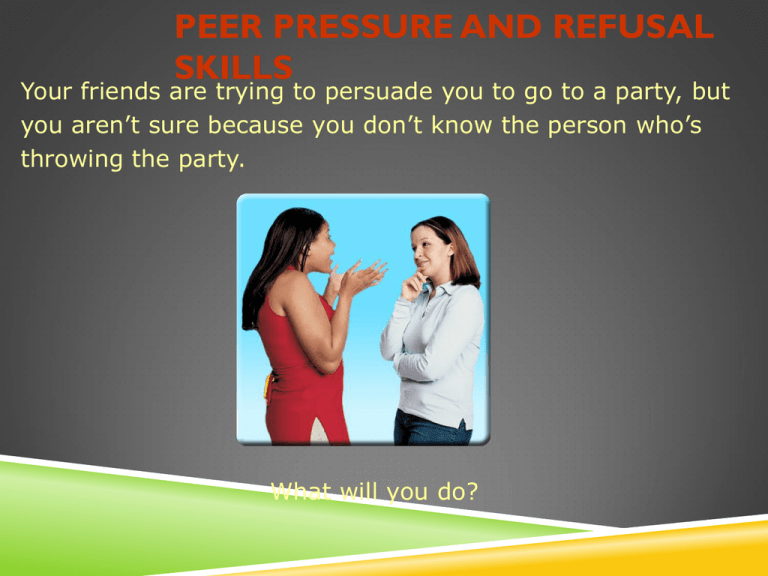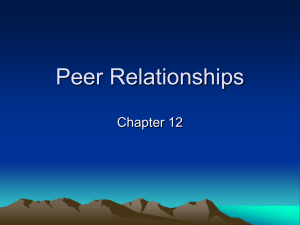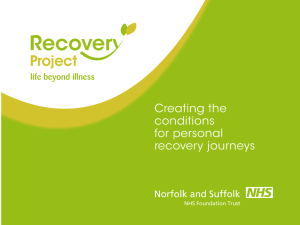Refusal skills Powerpoint
advertisement

PEER PRESSURE AND REFUSAL SKILLS Your friends are trying to persuade you to go to a party, but you aren’t sure because you don’t know the person who’s throwing the party. What will you do? LESSON OBJECTIVES In this lesson, you’ll learn to: Demonstrate refusal strategies and apply skills for making responsible decisions under pressure. Classify forms of communication such as passive, aggressive, or assertive. Analyze the relationship between the use of refusal skills and the avoidance of unsafe situations. PEER PRESSURE Peer Pressure Your peers can sometimes influence how you think, feel, and act. Peer pressure can have a positive or negative influence on your actions and behaviors. It is useful to learn to evaluate forms of peer pressure and develop healthful strategies for responding to it. PEER PRESSURE Positive Peer Pressure Peers can influence you in many positive ways. Positive peer pressure may involve not participating in risky behaviors or activities. You can also use positive peer pressure to influence others in healthful ways. You can be a role model by inspiring peers to take part in a positive act or a worthwhile cause. PEER PRESSURE Negative Peer Pressure Peers sometimes pressure others to take part in behaviors or accept beliefs that have negative consequences. Negative peer pressure can involve harassment, which includes name-calling, teasing, or bullying. Negative peer pressure may also lead some teens to engage in behaviors that go against their values. Manipulation is another way of exerting negative peer pressure on others. PEER PRESSURE Common Methods of Manipulation RESISTING NEGATIVE PEER PRESSURE How to Resist Peer Pressure One way to resist negative peer pressure is to avoid it. Develop friendships with people who share your values and interests. Have friends who stand by you and support your decision. RESISTING NEGATIVE PEER PRESSURE Things to Remember When Faced with Peer Pressure It is important to remain firm and stay true to yourself. Your health and safety come first. Make decisions that have the best possible effect on your well-being. Respect yourself, stand by your values, and be assertive in your refusal. RESISTING NEGATIVE PEER PRESSURE Assertive Refusal Assertive communication is when you state your position and stand your ground while acknowledging the rights of others. This is the most effective approach when facing negative peer influences. RESISTING NEGATIVE PEER PRESSURE Refusal Skills Effective refusal skills involve a three-step process. 1. State your position. Give an honest reason for your response. Offering a legitimate reason will help strengthen your refusal. 2. Suggest alternatives. Your suggestion is most effective if it takes you away from the dangerous or unpleasant situation. 3. Stand your ground. Use strong body language and maintain eye contact. RESISTING NEGATIVE PEER PRESSURE Body Language and Assertive Refusal RESISTING NEGATIVE PEER PRESSURE Passive and Aggressive Responses Passive Responses Aggressive Responses To some people, a passive response to negative peer pressure seems more natural. Teens who respond passively to peer pressure may believe they are making friends by going along. Passive people may be viewed as pushovers who aren’t worthy of respect. RESISTING NEGATIVE PEER PRESSURE Passive and Aggressive Responses Passive Responses Some people may feel more comfortable with an aggressive response. This may involve verbal or physical force. Aggressive Responses Most people react to aggressive behavior by avoiding the individual or by fighting back. RESISTING NEGATIVE PEER PRESSURE Assertive Communication Learning and practicing assertive communication is the most effective way to deal with peer pressure. Being assertive will help you resist negative peer pressure today, and it will also serve as a useful skill throughout your life. QUICK REVIEW Provide an analysis for the following question. Suppose a group of friends constantly teases a student in your school. In what ways can you show disapproval of this inconsiderate and disrespectful behavior? QUICK REVIEW Choose the appropriate option. Q. The influence that people your age may have on you is called ______. 1. harassment 2. manipulation 3. peer pressure 4. assertive communication QUICK REVIEW - ANSWER A. The influence that people your age may have on you is called peer pressure. Click Next to attempt another question. QUICK REVIEW Provide a short answer to the question given below. Q. Identify two examples of manipulation. Click Next to view the answer. QUICK REVIEW - ANSWER A. Some common methods of manipulation: Mocking or teasing another person in mean or hurtful ways Using “guilt trips” to get desired results Bargaining—offering to make a deal to get what one wants. Using flattery or praise to influence another person Bribing—promising money or favors if the person will do what is asked Making threats—promising violence or some other negative consequence if the person does not do what is asked Using blackmail—threatening to reveal some embarrassing or damaging information if the person does not do what is asked Click Next to attempt another question. QUICK REVIEW Provide a short answer to the question given below. Q. How might a friend help you resist negative peer pressure? Click Next to view the answer. QUICK REVIEW - ANSWER A. Friends who have respect for your health and well-being will be less likely to pressure you into doing something that goes against your values. You will find that it’s much easier to resist negative peer pressure from someone else when you have friends who stand by you and support your decision. Click Next to attempt another question.




